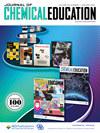3D打印绿色量热法──咖啡杯量热法
IF 2.9
3区 教育学
Q2 CHEMISTRY, MULTIDISCIPLINARY
Journal of Chemical Education
Pub Date : 2025-02-25
DOI:10.1021/acs.jchemed.4c0151110.1021/acs.jchemed.4c01511
引用次数: 0
摘要
聚苯乙烯杯通常用于高中和本科阶段的量热实验。然而,聚苯乙烯对环境的影响是众所周知的,人们需要这种不可再生资源的替代品,特别是在强制禁止聚苯乙烯的地方。这项工作描述了一个简单的3D打印容器(有两种形式,一种是2.5毫米的壁厚,另一种是5毫米的壁厚),其性能在统计上与单层或双层聚苯乙烯杯相同。这些容器可以在现场以最低的成本快速制造,并且耐用且可重复使用。3D打印的使用使聚苯乙烯成为一种绿色替代品。本文章由计算机程序翻译,如有差异,请以英文原文为准。
Green Calorimetry through 3D Printing─Coffee Cup Calorimetry
Polystyrene cups are commonly used for calorimetric experiments at the high school and undergraduate levels. However, the environmental impact of polystyrene is well-known and alternatives to this nonrenewable resource are desired, especially in localities where polystyrene bans are enforced. This work describes a simple, 3D printed container (made in two forms, one with a 2.5 mm wall thickness and a second with a 5 mm wall thickness) which behaves statistically identical to single or double layers of polystyrene cups. These containers can be rapidly manufactured on site at a minimal cost and are durable and reusable. The use of 3D printing allows for a green alternative to polystyrene.
求助全文
通过发布文献求助,成功后即可免费获取论文全文。
去求助
来源期刊

Journal of Chemical Education
化学-化学综合
CiteScore
5.60
自引率
50.00%
发文量
465
审稿时长
6.5 months
期刊介绍:
The Journal of Chemical Education is the official journal of the Division of Chemical Education of the American Chemical Society, co-published with the American Chemical Society Publications Division. Launched in 1924, the Journal of Chemical Education is the world’s premier chemical education journal. The Journal publishes peer-reviewed articles and related information as a resource to those in the field of chemical education and to those institutions that serve them. JCE typically addresses chemical content, activities, laboratory experiments, instructional methods, and pedagogies. The Journal serves as a means of communication among people across the world who are interested in the teaching and learning of chemistry. This includes instructors of chemistry from middle school through graduate school, professional staff who support these teaching activities, as well as some scientists in commerce, industry, and government.
 求助内容:
求助内容: 应助结果提醒方式:
应助结果提醒方式:


